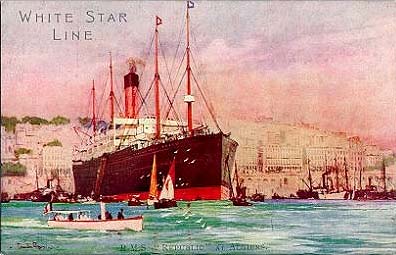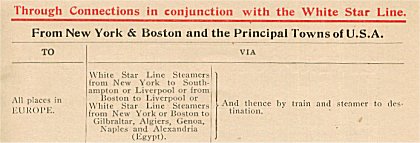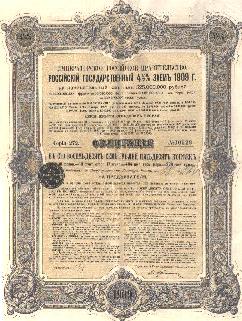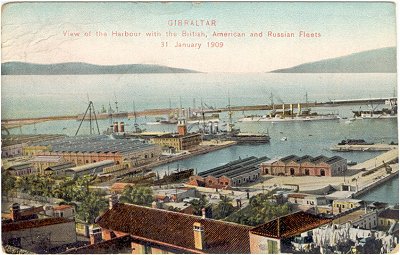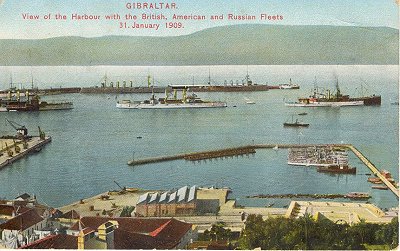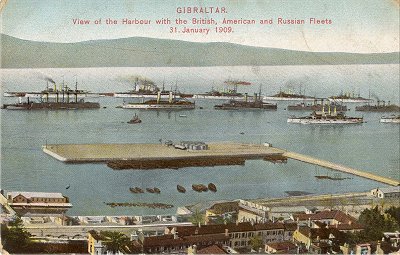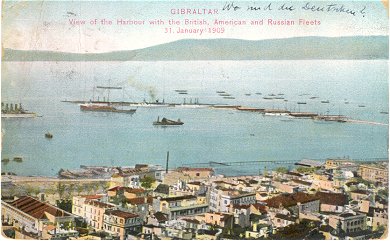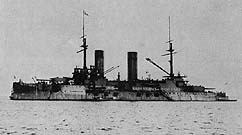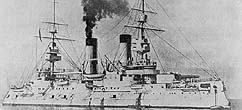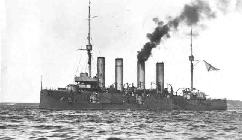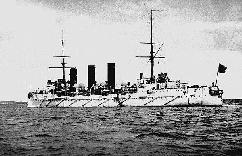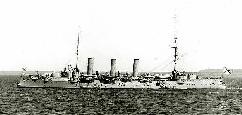Theoretical Loading Aboard The REPUBLICExport Report. Although this $3,000,000 American Gold Eagle engagement was included in the January 16th weekly U. S. Customs House export report and the REPUBLIC sailed on January 22nd (there were no gold exports to Europe included in the January 23rd weekly export report), these facts are not mutually exclusive if it is remembered that the REPUBLIC was at the White Star Line dock on January 13th and could have received this gold prior to the 16th export report and, therefore, be included in that report. In addition, it is likely that the White Star Line, owners of both the OCEANIC (the ship which "officially" carried this cargo, whose actual cargo is discussed in detail later) and the REPUBLIC, had secure pier or bonded storage facilities beyond Customs lines just as such facilities exist today at major ports, air terminals, etc. If, for example, the REPUBLIC had not been completely unloaded and was unprepared to load new cargo by January 16th, the gold could have been stored in such pier or bonded storage facilities before January 16th, be reported in the January 16th export report (because it had crossed Customs prior to the 16th), and be loaded aboard the REPUBLIC after the January 16th report. Destination. The REPUBLIC's destinations also do not preclude the possibility that she sailed with this $3,000,000 American Gold Eagle engagement. Her itinerary provided ample opportunity for direct or trans-shipment of this engagement, which was part of the $5,420,000 consigned "to Paris." ... These steamers... constitute a portion of the White Star Services from Boston and New York to the Mediterranean, including calls at Azores, Madeira, Gibraltar, Algiers, Palermo, Genoa, Naples, and Alexandria, according to the season. White Star Line booklet, circa 1908 NEW YORK - MEDITERRANEAN PORTS VIA AZORES These steamers are the largest vessels regularly employed in the trade, and afford an excellent opportunity of visiting the classic cities of Italy and the Mediterranean with every comfort. During the Egyptian season the New York Service is extended to Alexandria, thus enabling travelers to proceed to Cairo and other places of interest in the land of the Pharaohs. The steamers also call Eastbound during the season at Azores, Madeira, Gibraltar, Algiers and Monaco, and Westbound at Azores or Madeira.
Notes for First Class Passengers On Board The THE NEAR EAST Tours de Luxe including Egypt, The Nile, Holy Land, Turkey, Greece, Italy, &c., from New York Jan. 22, Feb. 13, 18, 27. Itineraries include the best of Mediterranean travel. EUROPE Short Winter Tours to Italy, Southern France (Riviera), &c., at frequent intervals. ... Thos. Cook & Son, travel agency ...She [the REPUBLIC] was due at Punta Delgada in the Azores January 29; Gibraltar, February 2; Genoa, February 5; Naples, February 7; and Alexandria February 11. ... N. Y. Sun, January 24, 09, 1:6 If the REPUBLIC had completed her crossing, a transshipment of a gold cargo could have occurred at any one of several of her scheduled ports of call such as at the Azores, Madeira, or Gibraltar; she could have connected at these ports with ships going to Cherbourg or Le Havre (the standard French gold ports), or Marseilles. Algiers and Monaco, French and quasi-French controlled ports respectively, were commonly ports of call for White Star Line Mediterranean Service and direct delivery to French banking interests at these ports is a second possibility. Another unpromoted stop at Marseilles (which had been a regular stop for Republic when she had been on Boston-Mediterranean service) or at any one of a number of other French or French controlled Mediterranean ports for direct delivery to French banking interests is a third possibility. Railroad transportation was well developed in Europe, and once arriving at any one of the northern Mediterranean ports, transportation of the gold by rail to Paris could have been provided. White Star Line Booklet ... If the tourist wishes to extend the journey [from the Mediterranean] into Continental Europe and Great Britain, tickets can be obtained, offering the advantages of a round-trip passage with choice of routes for the return voyage, and exceptional facilities for the overland journey [by rail and then cross-channel steamer] between the principal Mediterranean Ports and Liverpool, by the most attractive trans-continental tourist routes. White Star Line booklet, circa 1908, pg 7 After the collision and safe landing of the REPUBLIC's passengers, one of the alternatives offered by the White Star Line which allowed passengers to continue their trips involved rail transport. Railroad transportation can be seen as a not unordinary method of transportation between European cities and Mediterranean ports. [After the collision,] The White Star Line announced that the Republic's passengers would have the privilege of going to their respective points of destination on the White Star liner Romanic, which will sail for the Mediterranean from Boston at 5 a. m. on Saturday. Plans were also made to take those of the Republic's passengers who do not wish to go on the Romanic on the Red Star liner Vaderland, which sails from New York for Antwerp on Wednesday. The company is willing to transfer the passengers by rail for Mediterranean ports from Antwerp. ... N. Y. Tribune, January 24, 09, 1:6&7 The Third Theory Shipment - The Tsar's Gold
The Statist, London, Jan. 16, 1909, 96:2 The important feature of the situation last week was the resumption of gold exports to Europe in volume. . . . Included in the export was 3 millions [sic] gold coin; ordinarily coin would not be acceptable to French bankers for the Bank [of France] invariably prefers bars. Coin was, however, shipped and presumedly instead of being placed in the Bank it will, on its arrival, at Paris be deposited in the private banks at that center. . . . The movement of gold coin to Paris in increasing amounts last week was not surprising; internal loans of a speculative character are being brought out at Paris and the Russian bonds will be floated before the end of this month. In the distribution of these bonds it is expected that some considerable amounts will be exchanged at Berlin for matured [1904]2 Russian treasury notes and other sums will be remitted to St.Petersburg; in this process of exchange and distribution gold coin will be useful and after the loan shall have been placed doubtless remittances of gold will be large to Berlin and to the Russian capital. [Emphases supplied] The Financier, New York, Vol. XCIL, January 18, 1909, Page 232. The Bank of France was virtually the sole depository for all gold in France, maintaining the gold holdings/accounts of all of France's commercial banks. See: Purchase Operation. In fact, the original January 12, 1909, newspaper descriptions of the $3,000,000 transaction, loc. cit., indicated shipment of this gold coin engagement specifically to the Bank of France. The destination of this shipment has changed between the original reports of this engagement and this January 18th The Financier article. It would be extremely unusual for gold to be sent to the private banks in France, rather than to be deposited in the Bank of France for their account(s). loc. cit. If the gold coin was not destined for the Bank of France's vaults, and because the private banks did not maintain their own gold holdings, we can draw the implication that the $3,000,000 gold eagle shipment was, by January 18th, not at all destined for Paris, but was destined for St. Petersburg. The above article describes, in part, the settlement process, identifies 3 million in coin as the figure shipped (in conformance with several newspaper articles which appeared on January 14th and 15th, which describe the gold that remained to be shipped from New York AFTER the Oceanic's departure) and that gold coin would be needed at St. Petersburg as a result of this process. We can assume that the lowest cost for the French bankers for this shipment of gold was through the engagement of gold at New York. Payment for this shipment may have been made by the issuance of credits for the New York bankers on the London foreign exchange market (the exchange rate for this transaction was quoted at $4.875 per pound), and may have been in this sense a not-uncommon triangular transaction and consequent "indirect gold shipment," with the French bankers having this shipment delivered from their New York bankers directly to the Imperial Russian Government. The Bank of France did not prefer the receipt of foreign gold coin, but Russia held U.S. gold coin within its reserves. Of course, if we assume that the most favorable price for this gold was through its engagement and acquisition at New York, we should assume that one or more favorable cost factors existed at New York, particularly since the additional cost of abrasion of gold coins had - for this unusual transaction - to be also taken into account. If title to the gold passed to the Russian Government on January 22, 1909, at New York, the bankers would have saved both the cost of freight and insurance. Governments, of course, are self-insured. The cost of freight would then have been borne by the Russian Government.
RUSSIAN ATTACHE LEAVES.
New York Herald, January 23, 1909, 5:7. M. Wilenkin was a senior-level financial representative of the Russian Government, and an expert on Japan.3 As a consequence, he most likely had been involved in developing Russian strategy for the 1904 Russo-Japanese War, its financing and, therefore, the organization of the 1904 Russian Loan and its placement with the syndicate of French bankers and financiers who participated in that loan. The 1909 loan was designed, primarily, to re-finance the 1904 Russian Loan, then coming due in May, 1909. See: Motivation - The Survival of The Imperial Russian Government. If the Russian Government required an official representative to verify and accept the gold at New York, and make delivery arrangements to Russian interests, then M. Wilenkin would have been an ideal person to accomplish that task; he would have been known to the French bankers and was qualified to accept from them at New York on behalf of the Russian Government the $3 million in gold when the loan closed on January 22. Once M. Wilenkin's task was completed, the next day he departs the St. Regis and leaves New York. Another method that the banks may have used to reduce their costs would be to keep the gold within the US Government's possession as long as possible, until actual delivery to the ultimate consignee - saving themselves storage, packaging, freight, insurance and in-transit interest expense. Banks would acquire gold coin for export from the US Sub Treasury, and not from their own vaults. Gold in the vaults of the Sub Treasury is, of course, within the custody of the US Government. Payment to the US Government would not have to be made until the gold is removed from the Sub Treasury, i.e. removed from the custody of the US Government. Banks could reduce their costs (and, thereby increase their profits) if they could have the US Government deliver the gold not to them, but to the ultimate consignee; or, to put it another way, the banks could save expense if they could have the ultimate consignee "pick up" its gold directly from the US Government. Theoretically, if the gold could have been kept within the Government's custody until its removal from the Sub Treasury on January 22, 1909 when the Russian Loan closed, or better yet, if the US Government could make the delivery to Russian warships at Gibraltar (since the gold would remain technically in US custody until its release), discussed below, bankers would have saved virtually all of the standard expenses relating to the export of gold - and, made themselves a correspondingly greater profit. This scenario could explain the US Government's claim to ownership of all the gold aboard the Republic. Transshipment could take place at any French port, Turkey (Constantinople [now Istanbul]), or at any one of the REPUBLIC's other ports of call; at Gibraltar, for example, in addition to the American fleet, British, French and Russian warships capable of transshipment were also in port on the very date of the REPUBLIC's scheduled arrival.4 GIBRALTAR
Boston Journal, February 1, 1909, 12:1. [At the American Fleet's January 31, 1909 arrival at Gibraltar] ... There was something significant, the Americans noted, about this collection of Entente battleships in the shadow of the rock - the British Albion and Albemarle, the Russian Slava and Czarevitch [emphasis supplied, also spelled Tsesarevich], and three from France in addition to the American sixteen [battleships]. A young officer spoke of the "musical pandemonium" that resulted when the wind mixed the blare of all the national anthems being played at the same time. There was a smudge on the distant horizon as the German cruisers Hertha, Victoria, and Louise steamed by, ignoring the pageant entirely. ... The Great White Fleet; its voyage around the world, 1907-1909, GIBRALTAR January 31. - ... The first division arrives at Gibraltar and finds the British battleships Albemarle and Albion and the four ships of the British cruiser squadron, the Good Hope, Antrim, Carnarvon, and flagship Devonshire, under Rear-Admiral Sir Percy Scott, just returned from cruise to Africa and South America, the Russian battleships Tsarevitch and Slava and protected cruisers Bogatyr and Oleg, the French gunboat Cassini, and the German cruiser Heimdall [most probably the Danish cruiser Heimdal] lying inside the breakwater with sides manned, flags dipping, and bands playing. ...5 Monday February 1st 1909 . . . At 9:00 the Russian cruiser "Admiral Makaroff" stood in saluting Flag of Russian Admiral with 7 guns; returned with 7 guns, then exchanging national salutes with the shore battery . . . 6 Monday February 1st 1909 GIBRALTAR The January 12th, $3,000,000 American gold eagle engagement was the very last purchase of gold for the 4 1/2% 1909 Russian loan. Given the typical time parameters between engagement and actual shipment, and with the loan scheduled to close on January 21, 1909 (it was delayed a day, closing on January 22), it would have been impractical and more costly to ship the gold to France, and then to Russia. This writer believes the French banks, anticipating their gold requirements for the Russian Loan which was to close on January 21/22, 1909, made the commitment for the purchase of $3 million in gold on January 12, 1909, for delivery on the date the Russian loan closed. The French banks, on that later date, would then pay National City Bank and Goldman Sachs & Company for the gold, saving themselves interest expense between January 12 (the commitment) and January 22 (the delivery and payment). Once the loan closed on January 22, 1909, the gold was delivered to the White Star Line pier. The Russian government acquired title to the gold at New York, on January 22, 1909 when the loan was consummated and when delivery was made to the ship. The gold was placed aboard the REPUBLIC for shipment, the only ship on that date departing New York and bound for Mediterranean ports. If the Russian loan had closed as originally scheduled, a day earlier, shipment would have been made via Cunard's Carmania, then also on Mediterranean service with a scheduled port of call at Gibraltar. GIBRALTAR If the Republic had completed her voyage, transshipment would have occurred at Gibraltar to any of the men-of-war of the Russian Baltic Fleet, then and there present: As the REPUBLIC unloaded supplies to the American Fleet at Gibraltar, additional off-loading of "supplies" for the Russian Baltic Fleet would have gone unnoticed. Security at this transshipment point, at that time - with over twenty-five battleships and other men-of-war present and under the shore batteries of Gibraltar - was certainly at its greatest. British, American and Russian Fleets. The Great White Fleet at Gibralter on 31 January 1909, Russia's warships, however, were barred from Black Sea access from the Mediterranean. In 1841, England, France, Russia, Austria, and Prussia agreed to close the Bosporus and Dardanelles straits to all but Turkish warships in peacetime. This convention was formally reaffirmed by the Congress of Paris (1856) at the end of the Crimean War and, theoretically at least, remained in force until World War I.
J. N. Westwood, Witnesses of Tsushima If Russia were to transport gold via her warships, she could, of course, import gold through any one of her suitable Baltic Fleet naval bases, including: her naval base at Kronstadt, a town-satellite of St. Petersburg located on Kotlin island in the Gulf of Finland, a mere 18 miles/29 km WNW of the Tsar's capital; her normally ice-free naval base at Reval, today's Tallinn, at the mouth of the Gulf of Finland and 230 miles/370 km from St. Petersburg; her ice-free naval base at Libau, today's Liepaja, 560 miles/900 km from St. Petersburg; or through any other suitable Baltic Sea Russian port.8 After delivery to a Russian port, the gold would then continue its journey to St. Petersburg by rail. In theory, at least, there is nothing to prevent us from placing this specific and identifiable $3,000,000 American Gold Eagle engagement aboard the REPUBLIC. | ||||
FOOTNOTES1The REPUBLIC was the only vessel to leave New York on January 22, 1909, with Mediterranean ports of call. | ||||
| .. | ||||

